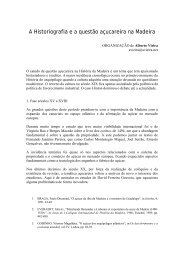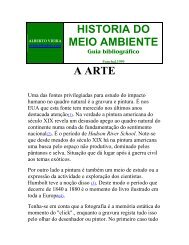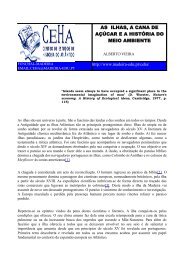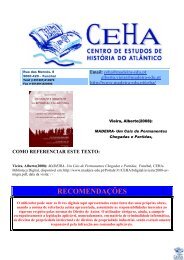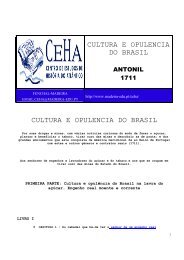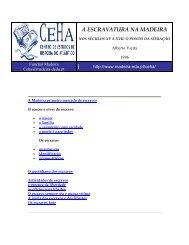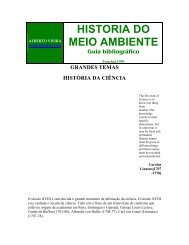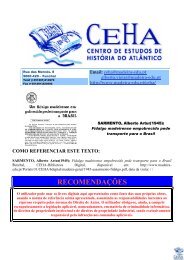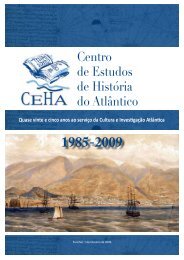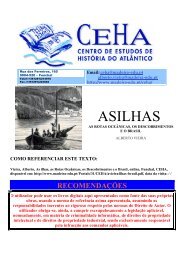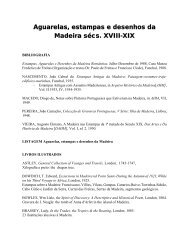SLAVERY IN MADEIRA
SLAVERY IN MADEIRA
SLAVERY IN MADEIRA
You also want an ePaper? Increase the reach of your titles
YUMPU automatically turns print PDFs into web optimized ePapers that Google loves.
On the other hand it should be pointed out that slave and freedmen devotion did not<br />
resume itself to the Brotherhood of Nossa Senhora do Rosßrio. The proof could be found<br />
in the parish of SÚ, with Maria Afonso, black, and Isabel Dias, coloured, whom<br />
established duties in here and in other brotherhoods such as in Santiago Maior, Reis<br />
Magos, Chagas, Nossa Senhora do Populo, Candelaria, Sao Bartolomeu, Sao JosÚ e Sao<br />
Diogo. But it is clear the preference for Nossa Senhora do Rosßrio. Maria Afonso, in<br />
establishing the legates to the Brotherhoods privileges Rosßrio, to which she gives 300<br />
reis and a house, while Isabel Dias donated one cellar and paid a duty through two church<br />
services in the altar of SÚ with the same invocation.<br />
The altar of Nossa Senhora do Rosßrio of Funchal's SÚ was object for a special devotion<br />
on the part of slaves and freedmen. In 1608, Maria das Neves, liberated coloured, was<br />
buried, at her request, in front of the referred altar. On the other hand, it should be<br />
mentioned that in the three situations where legates for the Brotherhood of Nossa<br />
Senhora do Rosßrio dos Pretos are mentioned, from the parish of Nossa Senhora do<br />
Calhau, the referenced people do not declare any ethnical detail, which might be a sign<br />
that in the above mentioned brotherhoods there was place for free, freedmen and slaves.<br />
Strangely, during our search in the available documentation for the Brotherhood of Nossa<br />
Senhora do Rosario of SÚ, created in 1583, we did not find any signs that would show<br />
the participation of Negroes, neither slaves nor free. The only reference that might be<br />
considered to clarify the situation is carved on the list of the Brotherhood's goods, where<br />
it is referred the existence of an altar cloth in the house of Maria Gonþalves, black,<br />
belonging to the Brotherhood.<br />
The Brotherhood did not limit itself to religious functioning, as to it were associated other<br />
interests of social impact. In the case of the Negroes the brotherhood of Nossa Senhora<br />
do Rosßrio still provided the necessary social support to the brothers and the means<br />
required for liberation. In Madeira we don't know of a case of liberation achieved this<br />
way, but we know that in 1622 Catarina Gonþalves handed over the brotherhood 15.000<br />
reis with this objective.<br />
The worship of Nossa Senhora das Neves, common for slaves, did not find great<br />
acceptance in Madeira, once that the existence of only one chapel dedicated to this patron<br />
saint is documented. In Sao Gonþalo, it was built during the XVI century on the orders of<br />
Joao Afonso Mealheiro and his wife Catarina de Sß. None of them is referenced as a<br />
slave owner, neither did we find any allusion of this cult on the part of slaves.<br />
8. THE SLAVES TODAY<br />
The presence in Madeira of a significant number of Canarian, North African and Guinea<br />
slaves might have made propitious, social and economic wise, multiple alterations in<br />
Madeiran daily-life. It is common to point out the various influences in the traditions,




